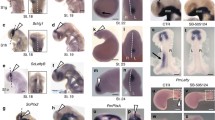Summary
The dorsal wall of the epithalamus of the elephant has two evaginations: the long recessus suprapinealis (RS) filled with plexus chorioideus and the short and wide recessus pinealis (RP). The thick part of the wall of both recessus consists mainly of pineal tissue with pinealocytes.
The ependyma of the epithalamic region has about 5 loci with circumventricular formations (CS), three of them belonging to the subcommissural organ. The ependyma with equivalents of high activity is situated in the lower lip and in the lateral tapering corners of the RP. This epithelium bears kinocilia and shows protrusions of the cells extending into the ventricle, it is fairly gomoripositive. Details concerning the structural differences in the various loci of CS are described.
There are some verrucae epithalami in the lateral wall of the epithalamus below the commissura habenularis having more or less deep clefts covered with ependyma. The possible functions of these structures are briefly discussed.
Zusammenfassung
Die dorsale Wand des Epithalamus des Elefanten enthält zwei Aussackungen, den langen Recessus suprapinealis (RS), der mit Plexus chorioideus gefüllt ist, und den kurzen breiten Recessus pinealis (RP). Die dickeren Wandpartien beider Recessus bestehen überwiegend aus Pinealgewebe mit Pinealocyten.
Das Ependym des Epithalamus bildet an fünf Orten circumventrikuläre Strukturen (CS); drei dieser CS gehören zum Subcommissuralorgan. Das Ependym mit der höchsten Aktivität liegt auf der unteren Lippe und in den spitzen lateralen Hörnern des RP. Dieses Epithel trägt Kinocilien und besitzt Zellprotrusionen; es ist mäßig gomoripositiv. Über die Verteilung der verschiedenen Kennzeichen der CS-Strukturen gibt eine Tabelle Auskunft.
In der lateralen Wand des Epithalamus unter der Commissura habenularis liegen die Verrucae epithalami, die unterschiedlich tiefe ependymbedeckte Spalten besitzen. Die mögliche funktionelle Bedeutung dieser Strukturen wird kurz erörtert.
Similar content being viewed by others
Literatur
Ariëns Kappers, J., Schadé, J. P.: Structure and function of the epiphysis cerebri. Progr. in Brain Res. 10, (1965).
Bargmann, W.: Die Epiphysis cerebri. Handbuch der mikroskopischen Anatomie des Menschen, Bd. 6, S. 309–502, Hrsg. W. v. Möllendorff. Berlin: Springer 1943.
Creutzfeldt, H. G.: Über das Fehlen der Epiphysis cerebri bei einigen Säugern. Anat. Anz. 42, 517–521 (1912).
Dexler, H.: Zur Anatomie des Zentralnervensystems von Elephas indicus. Festschrift zur Feier des 25jähr. Bestehens des Neurologischen Instituts. Arb. neurol. Inst. Univ. Wien 15 u. 16, 137–281 (1907).
Haug, H.: Zytoarchitektonische Untersuchungen an der Hirnrinde des Elefanten. Anat. Anz. 120, 331–337 (1967).
Haug, H.: Über markhaltige Nervenfasern und markhaltige Herringkörper in der Neurohypophyse des Elefanten. Z. Zellforsch. 96, 134–141 (1969a).
Haug, H.: Vergleichende, quantitative Untersuchungen an den Gehirnen des Menschen, des Elefanten und einiger Zahnwale. I. Mitteilung: Die Größe der Großhirnrinde. Med. Mschr. 23, 201–205 (1969b).
Haug, H.: Der makroskopische Aufbau des Großhirns. Qualitative und quantitative Untersuchungen an den Gehirnen des Menschen, der Delphinoideae und des Elefanten. Ergebn. Anat. Entwickl.-Gesch. 43, H. 4, (1970).
Hülsemann, M.: Vergleichende histologische Untersuchungen über das Vorkommen von Gliafasern in der Epiphysis cerebri von Säugetieren. Acta anat. (Basel) 66, 249–278 (1967).
Jordan, H. E.: The microscopic anatomy of the epiphysis of the opposum. Anat. Rec. 5, 325–338 (1911).
Krabbe, K. H.: Embryologische Untersuchungen des Hirndaches bei Tieren mit fehlender oder unterentwickelter Zirbeldrüse. Anat. Anz. 75, Erg.-Heft 160–170 (1932).
Krabbe, K. H.: Pineal body in Procavia. Acta psychiat. (Kbh.) 16, 183–190 (1941).
Leonhardt, H.: Bukettförmige Strukturen im Ependym der Regio hypothalamica des III. Ventrikels beim Kaninchen. Z. Zellforsch. 88, 297–317 (1968).
Leonhardt, H., Prien, H.: Eine weitere Art intraventrikulärer kolbenförmiger Axonendigungen aus dem IV. Ventrikel des Kaninchengehirns. Z. Zellforsch. 92, 394–399 (1968).
Merker, G.: Licht- und elektronenmikroskopische Studien über die Fasergliastruktur der Epiphysen-Subcommissuralregion der Primaten. Z. Zellforsch. 92, 232–255 (1968).
Oksche, A.: Vergleichende Untersuchungen über die sekretorische Aktivität des Subcommissuralorgans und den Gliacharakter seiner Zellen. Z. Zellforsch. 54, 549–612 (1961).
Oksche, A.: Survey of the development and comparative morphology of the pineal organ. Progr. in Brain Res. 10, 3–29 (1965).
Olsson, R.: The subcommissural organ. Stockholm: Ivar Haeggströms Boktryckeri AB 1958.
Palkovits, M., Inke, G., Lukács, G.: Der Subcommissuralkomplex (Subcommissuralorgan mit seinen Komponenten und Nachbargebilden) des Menschen während des postnatalen Lebens. Z. mikr.-anat. Forsch. 69, 88–108 (1962).
Quay, W. B.: Histological structure and cytology of the pineal organ in birds and mammals. Progr. in Brain Res. 10, 49–86 (1965).
Quay, W. B.: Pineal structure and composition in red and grey kangaroos. Anat. Rec. 154, 405 (1966).
Quay, W. B.: A mid-aqueductal ependymal organ in the brain of the hyrax (Procavia capensis). J. comp. Neurol. 142, 249–256 (1971).
Quay, W. B., Millar, R.: Organization and histology of the pineal region in the hyrax (Procavia capensis). Amer. J. Anat. 130, 377–392 (1971).
Shimuzu, N., Kumamoto, T.: A lead tetraacetate-Schiff-method for polysaccharides in tissue sections. Stain Technol. 27, 97–106 (1952).
Suzuki, Y.: Beiträge zur Anatomie des Epithalamus, besonders der Epiphyse, bei den Primaten. Arbeiten aus dem Anatom. Inst. der Univ., Sendai 21, 45–141 (1938).
Tilney, F., Warren, L. F.: The morphology and evolutional significance of the pineal body. The American Anatomical Memoirs 1919. Published by the Wistar Institute of Anatomy and Biology.
Author information
Authors and Affiliations
Additional information
Mit dankenswerter Unterstützung durch die Deutsche Forschungsgemeinschaft.
Rights and permissions
About this article
Cite this article
Haug, H. Die Epiphyse und die circumventrikulären Strukturen des Epithalamus im Gehirn des Elefanten (Loxodonta africana). Z.Zellforsch 129, 533–547 (1972). https://doi.org/10.1007/BF00316748
Received:
Issue Date:
DOI: https://doi.org/10.1007/BF00316748




